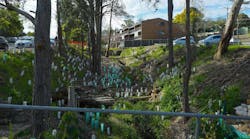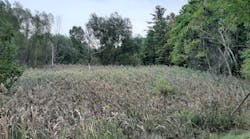Racing the Storm
On a northern California housing development last year, a developer raced against the weather to pace out the site and prevent sediment from the flowing into the storm drains. Located in the Sierra Nevada foothills near Sacramento, CA, the site is on hilly terrain with several hundred steeply terraced house lots and erodible soil.
Thunder Mountain Enterprises Inc., a local stormwater pollution prevention designer and installer, was called in to protect the drain inlets immediately after paving and just before a predicted rainfall. “Typically we work with our developers from the beginning,” explains Beth Smiley of Thunder Mountain. “We do the design, and then we work with them all the way through. A lot of scheduling has to do with their construction time line. Utilities go in, and pavement goes in shortly thereafter. So you’re just juggling getting everything protected. We encourage [developers] to get their utilities and pavement in before the wet season so they do have the ability to shed the water off of their sites.”
Although the lots were rough-graded and the developer was beginning to lay out some of the houses, nothing had yet been built on the site. The developer was concentrating on completing the paving work before the rains occurred and failed to get complete erosion and sediment control measures in place quickly enough. Thunder Mountain Enterprises was able to install drain inlet protection-Siltsack from ACF Environmental-before the storm hit.
The rainfall was significant-about an inch of rain in two hours. The Siltsacks were filled to the brim with sand and rocky sediment. They proved to be surprisingly strong and easily held the weight. “Normally when we design, these [Siltsacks] are the last line of defense,” observes Smiley. “The intent is not to have them ever fill like that but to do a combination of erosion control, which stabilizes the soil, and sediment control, which will stop soil particles that get into suspension before they reach the storm drain, with different BMPs. Our third and last line of defense is the Siltsack and protecting the drain inlet, the river, the creek, or whatever their outfall is.” Although intended to filter only fugitive sediment that has bypassed other BMPs, the Siltsacks captured all the sediment from the first storm. Thunder Mountain was able to implement additional erosion and sediment control measures to protect the site before the next rainfall event.
“Imagine if all the sediment went down the drain,” remarks Smiley. “We had to work quickly to install the appropriate erosion and sediment control measures, but the Siltsacks kept our customer out of trouble when nothing else could have saved them. The developer was happy.”

